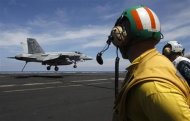By Andrea Shalal-Esa
WASHINGTON (Reuters) - The U.S. Navy on Thursday canceled a notice about a possible order of up to 36 more Boeing Co
F/A-18 fighter jets or EA-18G electronic warfare planes after the
posting on a federal procurement website sparked confusion this week.The pre-solicitation notice, which first became public this week, had triggered renewed questions about the Navy's commitment to the $392 billion radar-evading F-35 Joint Strike Fighter program by Lockheed Martin Corp .
Boeing has sought for years to sell the Navy more of its F/A-18E/F Super Hornets for use on aircraft carriers, as a hedge in case the more capable carrier variant of the F-35 fighter jet runs into further delays or technical challenges.
Navy officials this week said they had no plans to buy more Super Hornets or EA-18G Growlers in fiscal 2015 despite the notice on a federal procurement website. They said the notice was meant to ensure the "proper acquisition process" was in place if more U.S. or foreign orders materialized.
But the posting caught Pentagon officials by surprise, since the current Navy budget calls for F/A-18 funding to end in fiscal 2014, with production of the planes to end in 2016.
It was not immediately clear why Naval Air Systems Command, or Navair, decided to cancel the notice, which was first posted October 17. The procurement website was updated on Thursday to say the notice had been canceled, but no explanation was provided.
Officials with Navair, which oversees aviation programs such as the F/A-18, could not be reached for comment.
One U.S. official said the episode underscored the Navy's tepid commitment to the single-engine F-35 and the continuing attachment of many naval aviators to the Super Hornet, which has two engines.
"There is a desire at pretty significant levels in the Navy to keep the Super Hornet line alive," said the source, who was not authorized to speak publicly.
Lockheed is developing three models of the new warplane for the U.S. military and eight partner countries: Britain, Canada, Turkey, Italy, Norway, Australia, Denmark and the Netherlands. Israel and Japan have also placed orders.
The U.S. Marine Corps will be first service to start using the new radar-evading warplanes from mid-2015. The Air Force will follow a year later.
The Navy will be the last U.S. military service to start using its F-35 variant in 2019.
YOUNG FIGHTER FLEET
Unlike the other services, the Navy's current fleet of fighter jets is relatively young, bolstered by repeated increases in F/A-18 and EA-18G procurement in recent years, including many planes added to the Navy budget by lawmakers.
That fact has prompted debate about postponing the Navy's purchases of F-35s, but F-35 program officials and senior Pentagon leaders say that would drive up the cost of the remaining planes to be bought by the Air Force, Marine Corps and U.S. allies.
Boeing officials had no comment on the Navy's latest move.
The Chicago-based company is keen to sell the Navy and U.S. allies more F/A-18s to extend the life of its production line. It is pitching the Navy a range of upgrades for the Super Hornet, including an improved engine and fuel tanks that are hard to detect by enemy radar.
Boeing had hoped to land a big contract for F/A-18 fighters from Brazil, which would have extended the production line, but that order faltered after reports that the U.S. National Security Agency had spied on Brazil's president.
Boeing's F/A-18 is also short-listed in Malaysia's competition to replace 18 Russian-made MIG-29s, but Malaysian Prime Minister Najib Razak told Reuters on Thursday that the country's decision could be delayed by budget pressures.
U.S. defense officials say declining military budgets will force tough choices about weapons programs in coming years.
"Boeing argues that this country should have more than one fighter manufacturer, but the truth of the matter is we can't afford to have two fighter lines," said one U.S. official who was not authorized to speak publicly.
Boeing's F-15 fighter jet is now slated to end production in 2018 after completion of a large Saudi Arabian order.
Pentagon acquisition chief Frank Kendall told Reuters in September that he did not expect the U.S. Navy to significantly change its plans to buy F-35 fighter jets despite mounting budget pressures.
He said the Navy needed the added capabilities that the F-35 offered since other countries were developing their own radar-evading fighter planes, advanced electronic warfare capabilities and other advanced weapons.
"The F/A-18 is a great airplane, but it's a fourth generation fighter. The F-15 is a great airplane, the F-16 is a good airplane, but they're fourth generational fighters, and you get a quantum improvement in capability out of the F-35," Kendall said.
(Reporting by Andrea Shalal-Esa; Editing by Lisa Shumaker and Jim Loney)


No comments:
Post a Comment